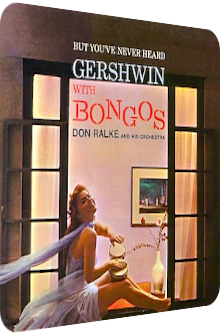
Don Ralke
But You've Never Heard
Gershwin With Bongos
1960
George Gershwin (1898–1937) was one of the most prolific composers and arrangers of the 21st century. His music has inspired a never-ending amount of musicians until this very day. Whether it’s piano-driven romantic kitsch or upbeat brass ditties, Gershwin and his brother Ira (1896–1983) came up time and again with unique stand-alone compositions or material for musicals that enchanted millions of people and made the Gershwins rich and famous. Since their material has been covered and reinterpreted so many times, it was as hard in the 60’s as it is today to come up with a new approach.
Bongo maestro Don Ralke (1920–2000), actually a music arranger and composer rather than a bongo player himself, tried to cash in during the pinnacle of a threefold craze: Afro-Bop, bongo music… and Exotica, naturally. But You’ve Never Heard Gershwin With Bongos was released in 1960 by Warner Music in the hope of continuing the string of previous successes Ralke had with his other records and his bongo-focused works Bongo Madness of 1957, a collaboration with a quintet whose most well-known player was Buddy Collette, and his jungle Exotica hallmark The Savage And The Sensuous Bongos, relased in 1960 as well. The twelve takes on Gershwin compositions that are grouped together on this album promise a resumption of Don Ralke’s mixture of brass-laden big band schemes and exotic bongo frenzy. Unfortunately, the album has its flaws, and they have mostly to do with the bongos and the waning creativity of Ralke who didn’t want to be reduced to his role as a bongo composer. However, the album has its good sides as well and actually starts in a strong way.
Don Ralke kicks off the list of Gershwin renditions with Fascinating Rhythm, a song originally written in 1924 which rose in popularity two years later when it was interwoven in the Broadway musical Lady Be Good, with Gershwin accompanying The Astaires on the piano. There’s literally no musician from the 50’s till 70’s who didn’t cover this particular gemstone. From Tony Bennett over Petula Clark to Ella Fitzgerald, there’s an endless amount of versions – but none is as lively and cheeky as Ralke’s take. Launching with a vivid bongo showcase and attenuating maracas, the following punchy brass eruptions, convivial flutes and the mélange of whirling vibraphone notes round off the swinging tune. I like Ralke’s interpretation quite a bit due to the brassy atmosphere and the focus on the bongos. The upbeat mood is much more revitalizing than the piano-focused pile of versions out there.
Next is How Long Has This Been Going On?, a 1928 contribution for the musical Funny Face. Since the retake of Jon Bon Jovi in 1994, this song will never be the same again and is spoilt for eternity, but luckily enough, Ralke is to the rescue with an intriguing concoction of dirty urban jungle saxes, silkier counterparts by the horn ensemble, wonderfully reduced piano sprinkles and, last but not least, a four-note bongo groove that is maintained throughout the song and runs as a golden thread through it, never changing even one bit, never distracting from the nocturnal glitz of the big city. A dreamy hymn that’s probably less keen on the exotic flavor than the depiction of a metropolitan skyline, but a welcome proof of the open nature of Gershwin’s songs.
Things get revved up in Clap Yo’ Hands, the hit single off Gershwin’s 1926 musical Oh, Kay! – the bongo groove is much more detailed and multilayered here, and the darkly droning horns at the beginning are soon in a lively exchange with their warmer brethren. The exotic highpoint of Ralke’s take, though, is the paradisiac flute in the limelight. It is almost swallowed by the brass blasts and bongo cascades, but can successfully take a stand in-between the voluminous thicket of glowing colors.
While the 1938 love theme Our Love Is Here To Stay is virtually taken apart by Ralke and morphed into an unexpectedly frantic, rhythm-changing anthem thanks to the staccato maraca-bongo couplet that counteracts against the allotted piano notes, alto flute melodiousness and the middle section with its typical jazzy double bass pith, the following world-famous and probably best known work of George Gershwin, Summertime of 1935, hides the bongos almost completely under a dense sound carpet of reverie-establishing vibraphones and a tremendously acidy and piercing wah-wah trumpet solo. The slow, careful beat is enchanting, but this is nonetheless Ralke’s blot of the album. The trumpet is too dirty and uproarious, destroying the huge potential of the composition. The same can be said about My One And Only, which surprises with scattered acid guitar twangs and a hectic bongo mixture, but smashes the created aura of these welcome ingredients with another wah-wah trumpet and a strange mixture of tenderly melting brass sections and too jazzy counterparts.
Side B immediately picks up the patchy thread of the last couple of songs off side A, but increases the quality nonetheless, while it decreases the overall reliance on the bongos at the same time. They All Laughed, written in 1937 for the film Shall We Dance, launches with wonderful over-the-top, sizzling-hot brass quakes, a high-plasticity bongo base frame, punchy orchestra drums and a vivacious interplay between the various brass instruments in all tone regions. The scattered piano and acid guitar glints are the icing on the cake. What didn’t work on Summertime and My One And Only is now triumphantly arranged by Don Ralke. The clarion attitude of the lead trumpet is much reduced, and while the brass melodies shimmer in glaring-red colors, their magnanimously resonating sound waves are lively and thunderous, but by no means overly grand, and that’s the reason why They All Laughed is considered a top pick by me.
The following Love Walked In is rather pale in direct comparison, but much more exotic, which is a good sign in the end: the bongos are more on the forefront on this take of the 1930 composition, and the jazzy double bass backing works marvelously with the balmy flute-vibraphone couple and the coltish curlicues of the brass ensemble. It is hence the trio of bongos, flutes and vibraphones that, thanks to the prominent inclusion, makes this one of the most exotic and laid back tunes in the spirit of Exotica quartets, despite the omnipresence of a multitude of horns.
It is They Can’t Take That Away From Me which returns to the wonderlands of brass with multiple golden shimmering horn groups. While they are clearly audible, they aren’t in the spotlight, but serve both the main melody on the trumpet and the acid guitar licks as underlining devices. The bongos are again a bit on the camouflaged side, merging all too well with the big band, and this doesn’t change in the following Maybe, originally written in 1926, making this an ancient composition by Pop standards. The percussive instruments are vanished almost completely and coupled with a more prominent double bass accompaniment, but this doesn’t destroy the dreamy atmosphere with warmly meandering brass accentuations, trumpet and trombone notes and the occasional upswell of the big band.
The penultimate A Foggy Day, originally written in 1937 for the movie A Damsel In Distress, sees Ralke in top form as he stays closely to Gershwin’s original, with all brass melodies intact and the heretofore biggest presentation of the acid guitar. The bongos are once again used as underlining percussive instruments that succumb to the energetic but highly melodious brass eruptions rather than taking a stand by pushing themselves forward, but this is rectified in the final rendition of the Jazz standard of 1930, I Got Rhythm, Gershwin’s best known upbeat composition. Again, Ralke doesn’t add too much nonsense or creative particles, but stays true to the seminal composition. Naturally, the bongos are much more in the spotlight, as are the soft maracas and the occasional vibraphone intersection. The proper focus remains on the eleven-note brass motif, as it should be. Don Ralke misses the chance for a creative outburst, but his rendition is faithful enough to be worth your while.
But You’ve Never Heard Gershwin With Bongos is a bit of a hybrid, ambiguous release. Don Ralke’s album fails in regard to the advertised unique selling point, the bongos, unsurprisingly. They are indeed plainly audible and add both a pinch of liveliness and a greater dose of plasticity to the arrangements. However, it is implied by the album title and Ralke’s style that the bongos remain incessantly in the spotlight. This is not the case here. While Ralke wasn’t all too happy about being reduced as "that bongo guy," the mixed bag he leaves in form of the twelve interpretations cannot be denied. The album starts really strong, but the novelty level wears thin all too soon, even more so since the novelty level itself doesn’t exist in the latter phase of the album when the use of the bongos is decreased and they are inferior to the ubiquitous brass attacks. The creativity is missing in the majority of the songs. Where are the frantic bongo solos? Where is the witty relationship between the various brass instruments and their percussive brethren? It is true that Gershwin’s material has never before been interpreted with this enormous amount of bongos. And still, considering Don Ralke’s preceding works, the bongos are too weak, lackluster and unimportant in the given circumstances. Fans of Gershwin, though, will be delighted about the little twists and slight changes that Ralke embedded in his takes, as most songs are clear-cut faithful renditions.
If you know the compositions of the New York-born prodigy by heart and are intrigued by this album due to the Gershwin angle, But You’ve Never Heard Gershwin With Bongos offers plenty of interesting instrumental versions. However, Exotica fans need to view this album through rose-tinted glasses if they want to eliminate its various flaws and interpretations by the numbers. On a positive side, if you aren’t here for the bongos and see them as a nice-to-have feature despite the auspicious title, your mileage may vary strongly from my opinion, and that would be great! I strongly advice Ralke’s milestone The Savage And The Sensuous Bongos for fans of the jungle kind of Exotica or Bongo Madness for some humble and unique Afro-Cuban Jazz themes. Fans of big band records and Gershwin in particular won’t harm themselves with Ralke's Gershwin album. Exotica fans should pre-listen. The album is readily available in various digital music stores.
Exotica Review 117: Don Ralke – But You've Never Heard Gershwin With Bongos (1960). Originally published on Sep. 8, 2012 at AmbientExotica.com.
